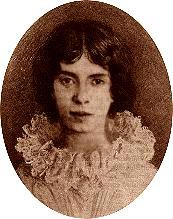|

|
Letters from Emily Dickinson: Emulating Emily Dickinson: Poetry Writing
Introduction:
Long perceived as a recluse who wrote purely in isolation, Emily Dickinson
in reality maintained many dynamic correspondences throughout her lifetime and
specifically sought out dialogues on her poetry. These correspondences—both
professional and private—reveal a poet keenly aware of the interdependent
relationship between poet and reader. In this lesson, students closely examine
Dickinson’s poem “There’s a certain slant of light”
in order to understand her craft. Students explore different components of Dickinson’s
poetry and then practice their own critical and poetry writing skills in an
emulation exercise. Finally, in the spirit of Dickinson’s correspondences,
students will exchange their poems and offer informed critiques of each others’
work.
For a complete introduction to the three lessons in this curriculum unit, Letters
from Emily Dickinson: "Will you be my preceptor?" review the curriculum
unit overview.
Guiding Question:
- What are some of the stylistic choices that Emily Dickinson uses to create
a sense of mood and voice in her poem, “There’s a certain slant
of light”?
Learning Objectives:
After completing this lesson, students will be able to
- Recognize Emily Dickinson's poetic style
- Engage in textual analysis and critical thinking of Dickinson’s poem
“There’s a certain Slant of light”
- Use imaginative writing techniques for creative and critical purposes
Preparing to Teach this Lesson:
Review the curriculum
unit overview and the lesson plan. Locate and bookmark suggested materials
and other useful websites. Download the pdf worksheet, Emulate
Emily, and cut out each individual quotation for distribution to student groups.
If necessary, download and print out any other documents you will use and duplicate
copies as necessary for student viewing.
Activities:
- As a class, read through "There's a certain Slant of light" (258), available both at the Academy of American Poets and the American Verse Project. Then, guide your students through an analysis of the poem. Your students should come to see how each element of the poem contributes to their understanding of the effect of this "certain Slant of light." You may want to include discussion of the following elements:
- Metaphors — Ask students to find the metaphors in the poem. They may point out that the "Slant of light" "oppresses, like the Heft/Of Cathedral Tunes," that "'Tis the Seal Despair," or that it is "an imperial affliction/Sent us of the Air." Make sure your students see that Dickinson uses these metaphors to describe her experience, most likely because there's no other way to approach this subject.
- Word Choice — What words does Dickinson choose? How do they inform your reading? The students may list "oppresses," "Despair," "heft," and "affliction." Certainly, this light is not entirely beneficent. They should also find many spiritual references: "Cathedral Tunes," "Heavenly Hurt," and "Sent us of the Air." Could the "light" suggest death? Your students may point out that it's "Winter" and "Afternoon"-times traditionally associated with death. They may also look at the concluding lines of the poem: "When it goes, 'tis like the Distance/On the look of Death—."
- Rhythm or Meter — Why does Dickinson use dashes in this poem? How does the rhythm of the piece contribute to its meaning? Your students may see the dashes as pauses, adding weight to the ideas. You could point out how the dashes around "hold their breath" give the impression of someone or something holding its breath or how, in line 9, the dashes around "Any" emphasize the impossibility of this sensation ever being taught.
- Personification — Ask the students to find the personification in the last stanza. They should note that the "Landscape listens" and the "Shadows—hold their breath—." Encourage them to think about what this adds to the poem? Does the speaker project these reactions onto nature? Why? What can that tell us about the speaker?
- Pass out the Emulate Emily handout to every student. Have students complete the first part of the assignment, which asks them to think again about how the poem "There's a certain Slant of light" presents its message, and then to write a poem of their own emulating it, in class or for homework.
- Once they've written their poem, have students follow step #4 from the Emulate Emily handout. They will exchange their poems with their partners and offer critiques, based on what they've learned thus far in the lesson. Finally, students will, in step #5 from the Emulate Emily handout, write a one-page essay describing what they have learned.
Extending the Lesson
- Have the students read the poem "Emily Dickinson" by contemporary poet Linda
Pastan. The poem is available from Titanic
Operas, Folio 1 on the Dickinson
Electronic Archives through the EDSITEment reviewed Academy
of American Poets site. Note how Pastan addresses and then challenges
the myth of Dickinson. Ask the students to consider how Pastan responds to
Dickinson's poetry and her image and how she expresses her views through her
poem. Then, have your students pen a poem that reflects their perceptions
of Dickinson and her influence on them.
Selected EDSITEment Websites
- American Verse Project
[http://www.hti.umich.edu/a/amverse/] to be used for the edited text of Dickinson's
poems.
- Academy of American Poets
[http://www.poets.org]
- Emily
Dickinson
[http://www.poets.org/poets/poets.cfm?45442B7C000C07000F] Provides a biography
of the poet, selected poems, and links to additional Web resources.
Standards Alignment
View your state’s standards
|





